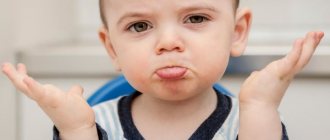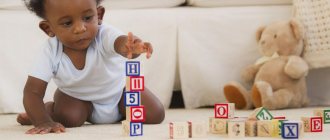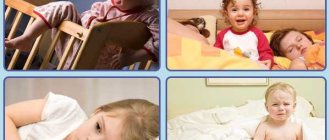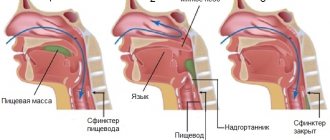Norms of speech development
Approximately, a two-year-old child’s vocabulary contains 100-300 words. Generalized words such as shoes, dishes, fruits, toys, and less frequently, imitation words (moo-moo, bi-bi) are becoming more and more common. Of course, a child may confuse concepts within generalized groups, calling sandals slippers or boots, and a sweater a T-shirt or jacket. But as the vocabulary expands, words will take their place. It is difficult for a child to pronounce long structures rich in difficult sounds, since the speech apparatus is not sufficiently prepared for this.
At this age, speech may not be understandable, but with each month of practice it improves and is filled with greater meaning. The child pronounces sentences consisting of two or more words, replacing some with facial expressions and gestures. The speech is emotional and brightly colored. It is now much easier not only for parents, but also for other people to understand the baby. The passive vocabulary is also replenished with a new stock (the child’s internal vocabulary, consisting of those words that he understands.) Closer to three years, speech is filled with active word creation, building new words from existing ones. The awareness of one’s own “I” changes, and the expressions “Anya will go on her own” change to “I will go on my own.” Sound content undergoes changes during the third year of life.
The approximate distribution of speech abilities is shown in the table.
| Age | Speech abilities |
| 2 years 2 months | The baby uses adjectives, pronouns, prepositions |
| 2 years 3 months | Writing three-syllable sentences |
| 2 years 4 months | Appearance of more than 5 common offers |
| 2.5 years – 2.9 years. | Increased vocabulary, the complexity of difficult-to-articulate sounds is preserved (whistling, hissing, sonorant groups) |
| 2.9 -3 years | Active dictionary up to 1000 words |
Speech development in girls occurs more rapidly than in boys. According to statistics, girls begin to construct sentences earlier and avoid imitation words. Researchers from foreign countries have established a pattern of earlier speech development in girls. As is known, at 2 years of age the active vocabulary of females is significantly greater than that of males. And, as a result, speech experience does its job. It’s easier to build sentences and choose words. Even pronouncing words and certain sounds is easier for girls.
Two-year-old silent ones
It happens that children, having crossed the milestone of 24 months, do not begin to delight their loved ones with funny conversations. All that remains are onomatopoeia, fragments of words, or “mooing,” facial expressions and gestures. What is the reason and are these circumstances a pathology? After all, all children are completely different in their development. Still, it is not advisable to ignore existing norms.
If such a problem arises in the family, parents must identify the cause, since two years is the most sensitive period for the formation and development of a child’s cognitive abilities. Perhaps the child is developing along an individual path, and will soon catch up with his peers. But the reasons for delayed speech development may be different, and time for acceptance will be missed.
You should understand what parents mean by the concept “the child does not talk”:
- says nothing at all;
- speaks indistinctly, without making certain sounds;
- speaks less than parents would like (either in comparison of parents with themselves in childhood or with previous children in this family);
- pronounces inaudible sounds that do not resemble words;
- unable to connect words in sentences;
- does not speak, but can point to an object, understanding what it is about;
- does not speak at all, does not perceive the interlocutor, does not find communication.
In each individual case, correctional activities will be structured differently. It may be completely inappropriate, but the source of the problem must be found out. There are many factors that influence a child's speech development.
Let's consider two options.
The child does not speak, but understands everything
This is where expressive speech disorder occurs. A common problem in the modern world: “He understands everything, but doesn’t want to talk.” Comparing their child with their peers, parents involuntarily understand that something is wrong, but begin to look for a way out of the situation closer to three years. Perhaps the child has dysarthria (a problem with the articulatory apparatus), as a result of which the baby does not accumulate vocabulary. Maybe there is some kind of psychological background. It is important to note other signs:
- preservation of hearing and intelligence;
- psychophysiological development corresponds to the norm;
- there is communication through facial expressions and gestures, adequate emotional manifestation;
- There are no signs of autism spectrum disorders, the manifestations of which can be noticed from the age of 2.
Does not speak or understand spoken language
Concurrent expressive and expressive language disorder. This problem is much more complicated than the previous one. It is necessary to contact specialists and conduct a differential diagnosis with various disorders: hearing defects, intellectual impairments, emotional-volitional disorders. If no extraneous pathologies accompanying speech pathologies are identified, sensorimotor alalia occurs. Such a diagnosis can only be made by a neurologist, having appropriate grounds for this. And correctional work will be carried out under the careful supervision of a speech therapist-defectologist. The problem requires immediate correction, since over time the baby’s speech will not change; he needs speech therapy help.
Factors influencing speech formation and what to do
Exogenous (external) factors
Problems not related to the child's intellectual capabilities.
- Speech atmosphere in the family. A lack of communication can lead to a child not developing a predisposition to imitate. If parents practically do not talk to their child, citing being busy or tired, he will simply have no one to learn to speak from. Therefore, from the first days of life it is necessary to devote time to communicating with the baby.
- A special psychotype of a child. The baby gets acquainted with the world, observes it, forms a passive vocabulary and comprehends what he sees.
- Distortion of speech by adults imitating a child. Parents, without realizing it, can seriously harm the child’s correct perception of speech by distorting words and excessively using diminutive suffixes.
- Pedagogical neglect. A situation typical of dysfunctional families in which the child is not given due attention. At the same time, conflicts often occur that traumatize the child’s psyche, fights, and swearing.
- Overprotection. Excessive care of parents for their child, in which the child has no motivation for independent activities, including speech. The baby has no need to show speech activity; his loved ones understand and fulfill his wishes without a word, finish phrases, finish sentences.
- Psychological trauma. They may be associated with early separation from the mother, due to various factors.
Endogenous (internal) factors
These include the physiological characteristics of the child’s body that affect speech formation.
- Problems of intrauterine development (hypoxia during pregnancy, toxicosis, birth trauma, infectious diseases of the mother) can in one way or another affect the speech centers of the baby’s cerebral cortex and subsequently affect the development of speech.
- Impaired physical hearing. Decreased auditory perception entails underdevelopment of children's speech. It happens that a child reacts to many sounds of the surrounding world, but the frequency of human speech is inaccessible to him.
- Organic lesions of the speech areas of the cerebral cortex due to birth trauma or anomalies of the prenatal period cause a complete absence or partial underdevelopment of speech (alalia). Much more common in boys. In this case, the manifestations look different. Depending on the location of the lesion. In children, such a complication can manifest itself either in a complete refusal of verbal communication, or in a lack of understanding of what adults want from him.
- Insufficient maturation of the central nervous system, inhibiting speech development (premature babies).
- Defects of the articulatory apparatus: mobility of the tongue, hypoglossal ligament, tone of the muscles of the lips, face (specialists such as a speech therapist and a neurologist will help in this matter).
Pathologies that are more complex in structure and persistent in nature can also be the cause of delayed speech development:
- Intellectual impairment is represented by a primary defect, and speech impairment is a secondary manifestation.
- Autism spectrum disorders. With this developmental anomaly, as with all other defects, speech is not the only sign indicating this problem. Therefore, under no circumstances should you try everything on your child.
Reasons for silence
They can be physiological (pathologies of organ development or dysfunction), psychological and social.
- One of the reasons is complete or partial deafness.
- Neurological problems.
- Pathology of development of the speech apparatus.
- Consequences of stress or fear.
- Insufficient attention of parents, they do little with their son or daughter; the child does not receive speech experience; If the mother is silent, then the child will be taciturn. The baby needs a speech environment.
- Mental illnesses.
What could be a warning sign for parents?
As mentioned earlier, all children develop according to an individual scenario. But some processes in development make it possible to track the emerging problem and take the necessary measures, since speech development leaves a mark on the mental and cognitive. If questions arise, it would be a good idea to visit a professional neurologist specializing in speech practice.
What you should pay attention to:
- remember how the baby’s speech initially developed. Has she gone through all the stages: humming, babbling, first words? Was speech development interrupted?
- whether the child understands the speech addressed to him and reacts to it;
- the child does not fulfill simple requests (give, put, bring), does not look at the adult, does not respond to his name;
- the baby does not know how to ask, to approach the desired object, screams loudly, throws a tantrum;
- by the age of two, the baby has very few words, he hums, does not pronounce the usual words, and also does not perceive the speech of others well;
- or, conversely, repeats complex words meaninglessly, aimlessly, without using them as communication or communication;
- neurological manifestations in combination with speech underdevelopment, such as: walking on toes, tremor (shaking) of the chin, hands, poor motor skills;
- stereotypical (similar) movements not used for play - walking in a circle, opening or closing a door, lining up toys in a row.
These symptoms can be dangerous if they occur together. Otherwise, panic is inappropriate.
Which specialists will help?
If such manifestations are detected in a child, the main thing is not to miss the deadline. Modern medicine and pedagogy are filled with methods for developing speech and eliminating problems. It is necessary to undergo a comprehensive examination. First, visit a pediatrician who can help with referrals to the right specialists:
- Otolaryngologist (ENT). Eliminates hearing and articulation defects. If a problem is identified, he will refer you for additional research and advise you to visit an audiologist.
- Neurologist. It will help to understand the problems of the development of the child’s nervous system, with deviations in mental processes. He will prescribe a set of various studies, some of them are an audiogram, an echogram, an encephalogram. Prescribe medications that promote the development of brain activity.
- Speech pathologist-defectologist. Checks possible anomalies of the articulatory apparatus and the level of speech development. Recommends various exercises for the tongue to parents, as well as tactics for inducing speech in children.
Specialists will help you collect an overall picture of the child’s formation and figure out whether deviations really exist.
What to do if the child does not speak
If the child does not have serious pathologies, every parent can help their child start talking. Below are recommendations from experts that will help get the most silent little one talking.
Advice from speech therapists
- Encourage your child to communicate. Try to talk to your baby more. Name the objects you see around you, try to pronounce words to your child slowly and clearly.
- Try to communicate with your child correctly, without distorting words.
- Encourage and praise your baby for any sounds and attempts to pronounce words.
- Ask open-ended questions: who is in the picture? What is the name of this doll? What color is this car?
- Don't rush him to answer. Wait for the baby to answer, do not interrupt him, getting ahead of him with the answer to the question asked.
- Try to read books to your baby more and tell fairy tales. This will enrich his vocabulary and promote speech development.
- Sing simple songs. Humming songs with your baby will also have a positive effect on his speech development.
- Do articulatory gymnastics. Try to spend 10-15 minutes exercising daily. This time will be enough for the baby to learn to control his lips and tongue.
- Teach your baby to breathe correctly. Correct speech breathing will help him learn to correctly pronounce sounds and then words. Speech inhalation must be done through the nose, speech exhalation through the mouth.
How to develop the speech abilities of two-year-olds
Even if a child is recommended to have classes with a speech pathologist (sometimes expensive), at the age of two they are short-term. The baby does this activity for 10-15 minutes. Exercises are organized only in the form of a game and can be successfully performed by parents independently. It must be remembered that the baby will require increased activity from adults. It is necessary to pronounce each of your actions, ask, call for a conversation, answer questions, motivate, pronounce words together.
Exercises are carried out only with positive emotions, as in this case there will be results. In order to consolidate a skill, repeated repetitions are necessary. In games, be sure to use visual material, bright toys, pictures that will interest the baby’s attention. It would also be a good idea to take into account the child’s experience of understanding the world around him, not to utter incomprehensible words, and not to construct long sentences. Shorten words by pointing to objects. Material for games is selected according to the principle from simple to complex. Classes should include a variety of activities aimed at developing specific skills.
For the slightest achievements of the baby, hug, kiss, show emotions, since a child, even at this age, is already able to establish cause-and-effect relationships. If mom is happy, then we need to “do it again”! The baby learns about the world by imitating adults, and therefore in the game you should interest your silent child as much as possible.
Choosing games
The main task of an adult is to teach the child to imitate. The main principle of learning is gradualism and slowness.
- “Let’s do exercises.” The point of the game is that the adult comes up with exercises that the baby would repeat and perform with him: clapping, jumping, steps, swinging his arms and legs. At first, the movements are performed separately, then the material becomes more complex and additional ones are added, for example, clapping your hands and walking in place.
- Fun logorhythmics. These are musical games for developing the rhythm and feeling of music, as well as the use of simple words for movements: “Clap-clap, stomp-stomp.” An adult must pronounce all actions to the music. Such activities have a beneficial effect on the child’s speech and motor development and allow them to quickly achieve a positive effect and emotional response, especially if they are performed together with their beloved mother.
- "Games with objects." For example, we bathe the Katya doll. Mom pronounces each action: “Let's take the doll, undress her, and then put her in the bath. Let’s pour some lukewarm water so that the doll will be pleased...” We define the process as much as possible, and the necessary attributes for the game, such as a bathtub and water, will help make the process interesting and captivating the child’s attention. Your baby will definitely begin to imitate actions, and subsequently try to pronounce words with you.
- Nursery rhyme games. It’s not for nothing that our great-grandmothers knew all kinds of jokes filled with folklore. Such sayings are easy to remember and repeat, and are most understandable to children with their simple rhythms. They are used in the development of speech of two-year-old children. “Okay-okay”, “Guli-guli” and much more.
- Games with small objects. Training fine motor skills directly related to the speech areas of the cerebral cortex. Invite your little one to tear together a sheet of colored paper into small pieces, and then assemble some kind of composition from them, being sure to praise your little helper. During joint activities, pronounce each action, for example, “drip-drip, it began to rain, whew-fuh, the snow flew, rust-shur, the wind blew.”
- You can build a finger pool from various safe small fillers, and, under close supervision, “bathe” small fingers, talking through what is happening.
- Get your little one used to reading children's books together. To begin with, you need books without text, with bright, large, colorful pictures; music books help best here. When showing pictures, we describe what we have drawn in our own words, pay attention to the details, stop, examine, and pronounce. Then you can use illustrated books with short poetic summaries written in capital letters so that the baby gets used to the fact that books can be read and listened to.
- "Sounds of animals and objects." You can use animal model toys, or you can use painting material. "Who is this? Hen! What does the chicken say? Ko-ko-ko." "What is this? Airplane! How does the plane sound? Oooh." Such exercises significantly develop the child’s articulation; you can blow like a breeze, “Sh-sh-sh,” and ring like a mosquito, “S-s-s.” Not only the articulatory apparatus develops, but also phonemic hearing, which is responsible for distinguishing speech and non-speech sounds. We focus the child's attention on the fact that individual sounds can be pronounced.
- Development of general motor skills. Coordination of body movements. Playing with a ball, big and small, will help. They also contribute to the positive dynamics of playing fitball. There is a set of exercises aimed at developing the baby’s physical abilities. And, as you know, psychophysical development works in conjunction with psycho-speech development.
When working with non-speaking children, it is necessary to understand that the speech environment must be properly organized and motivation for joint activities must be created. You need to be prepared for the fact that everything will not work out right away; it will take some time to find contact with the baby. In some cases, working together with a neurologist will help achieve positive results. Probably, two years for parents of a non-speaking child is absolutely no reason to panic, but in any case, joint work on speech development will not be superfluous, but will only help the baby form a correct and timely understanding of the world around him.
How to help a child talk?
Expanding the child’s thoughts, helping him put them into simple, clear phrases - by doing this we help the formation of a passive vocabulary, which over time develops into active speech. Let the baby touch the bark of a tree, smell a flower, say hello to a person passing by.
Introduce new words in different combinations and contexts. It is very important to try to understand children’s speech and “translate” it into an adult way. For example, the word “mom” alone can mean “mom, look,” “mom, have pity,” “mom, play,” “mom, get it,” “this is my mom,” and so on.
The development of fine motor skills of the hands helps to develop speech. The connection between the development of finger movements and speech has long been proven by psychologists. Therefore, it is necessary to introduce finger games and other activities into daily communication - playing with paper, unscrewing lids, finger painting on semolina. Let the child, under the guidance of an adult, take out and fold cotton swabs, glue the beans onto a piece of salt dough or plasticine. In nature, a child and his family can pick currants or raspberries from a bush.
Read more about how to develop fine motor skills here.
Try to engage with your child in a playful way, pronounce words with him. To make him more comfortable, position yourself opposite him so that your eyes are at the same level. Use the same words so he can remember them and short phrases.
The parent’s speech during the period of classes with the child should become as simplified and monosyllabic as possible. Simplify even the child’s name - not Alexander, but Sasha, not Dmitry, but Dima, Mitya. Use words with simplified articulation, with sounds that the child knows and can pronounce (“s”, “p”, “m”, “b”). You can make a joint album and paste photographs of relatives and friends there, and then sign them by name. Try to build short but schematic sentences with your child.
If the child’s vocabulary has already been slightly enriched with simple words, such as the names of animals, then you can add action words to them, such as “kitty, go,” “cockerel, crow.” Over time, the child will understand the algorithm of actions and begin to say so himself.
Find out more information about how to develop speech in a child aged 2-3 years here.
Work of specialists
When specialists work together with parents, the reasons why the child cannot speak are corrected and cured. The formation of speech is directly related to the mental and psychological development of the child. Various genetic diseases, autism, mental retardation, Down syndrome will undoubtedly affect speech. Working with specialized specialists will help to establish communications and correct the development of speech.
If there are such problems, first of all, the child is checked by an otolaryngologist - if everything is in order with the hearing, then a neurologist gets to work. In addition to corrective classes, he may prescribe the use of nootropic drugs to influence the higher integrative functions of the brain and improve memory and learning (Cortexin, Encephabol, Nootropil).
It is also possible to involve a speech therapist, but most specialists do not work with children under 4 years old, which complicates the situation. But there are still speech pathologists and speech pathologists who take on the treatment of even the youngest patients.
Be sure to contact a qualified specialist who has an education diploma. He must come with a set of aids, with the help of which he works with the child. Ideal if these are bright pictures. The doctor himself must have a correctly delivered, competent speech. He should find a common language with the baby and conduct training in a playful way.
What to do for parents - useful recommendations
Some parents mistakenly believe that television can help teach speech skills. This is wrong. When a child hears speech from speakers, his body does not react to the sounds in any way.
First of all, parents should develop the child’s fine motor skills. It has long been proven that speech areas are formed under the influence of impulses from the fingers.
Parents can work with their child on their own. But this should be an addition to classes with a neurologist, and not an alternative. Massage and training of children's fingers speed up the process of speech development.
You should also teach your child various words in a playful way. You can purchase or make yourself a series of cards depicting objects: vehicles, animals, birds, insects, people. The pictures should be bright, but simple in execution and understandable to the child. You can let your baby look at them several times a day.
The child can not only name objects, but also depict how an airplane hums or a cat meows, thereby stimulating onomatopoeia.
Over time, you can start asking your child questions: “Who is this?”, “What is this?”, “How does the horse gallop?”, “How does the dog bark?”, and then tell him that “The car is driving”, “The cat is running” and etc. And it is not at all necessary to wait until the child himself begins to answer your questions.
The main thing is for the baby to hear and see the parents say this. Gradually he will begin to imitate you and start talking.
At the same time, there is a list of things that parents should not do:
- compare your children with other children;
- let noticed problems go by themselves;
- become overly focused on a problem.
Should you worry if a child does not speak at 2.5 years old, and how parents can develop their child’s speech skills, speech therapist Oksana Lavrinenko explains in this video:











